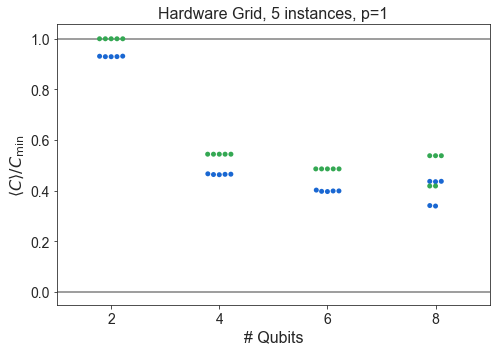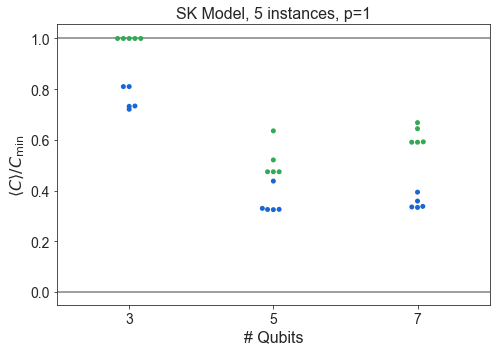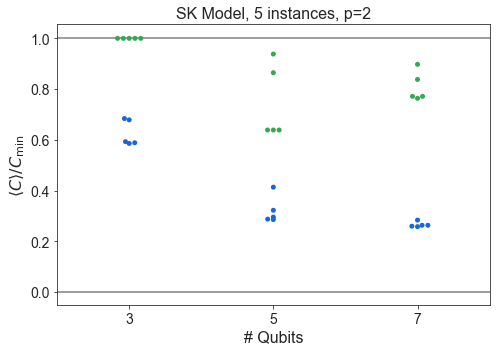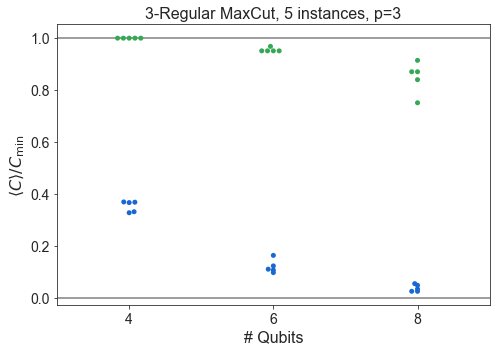Precomptued Analysis¶
Use precomputed optimal angles to measure the expected value of \(\langle C \rangle\) across a variety of problem types, sizes, \(p\)-depth, and random instances.
Load in Raw Data¶
Go through each record, load in supporting objects, flatten everything into records, and put into a massive dataframe.
[1]:
import recirq
import cirq
import numpy as np
import pandas as pd
from recirq.qaoa.experiments.precomputed_execution_tasks import \
DEFAULT_BASE_DIR, DEFAULT_PROBLEM_GENERATION_BASE_DIR, DEFAULT_PRECOMPUTATION_BASE_DIR
records = []
for record in recirq.iterload_records(dataset_id="2020-03-tutorial", base_dir=DEFAULT_BASE_DIR):
dc_task = record['task']
apre_task = dc_task.precomputation_task
pgen_task = apre_task.generation_task
problem = recirq.load(pgen_task, base_dir=DEFAULT_PROBLEM_GENERATION_BASE_DIR)['problem']
record['problem'] = problem.graph
record['problem_type'] = problem.__class__.__name__
record['optimum'] = recirq.load(apre_task, base_dir=DEFAULT_PRECOMPUTATION_BASE_DIR)['optimum']
record['bitstrings'] = record['bitstrings'].bits
recirq.flatten_dataclass_into_record(record, 'task')
recirq.flatten_dataclass_into_record(record, 'precomputation_task')
recirq.flatten_dataclass_into_record(record, 'generation_task')
recirq.flatten_dataclass_into_record(record, 'optimum')
records.append(record)
df_raw = pd.DataFrame(records)
df_raw['timestamp'] = pd.to_datetime(df_raw['timestamp'])
df_raw.head()
[1]:
| timestamp | bitstrings | qubits | final_qubits | circuit | violation_indices | problem | problem_type | dataset_id | device_name | ... | generation_task.dataset_id | generation_task.device_name | instance_i | n_qubits | optimum.p | f_val | gammas | betas | min_c | max_c | |
|---|---|---|---|---|---|---|---|---|---|---|---|---|---|---|---|---|---|---|---|---|---|
| 0 | 2020-04-08 13:11:32.151452 | [[0, 0, 0, 0], [0, 0, 1, 0], [1, 1, 1, 1], [0,... | [(5, 3), (6, 2), (6, 3), (6, 4)] | [(5, 3), (6, 2), (6, 3), (6, 4)] | [(PhX(-0.824)^0.5((5, 3)), PhX(-0.824)^0.5((6,... | [] | (2, 0, 1, 3) | HardwareGridProblem | 2020-03-tutorial | Syc23-simulator | ... | 2020-03-tutorial | Sycamore23 | 4 | 4 | 2 | -2.616073 | [0.47109541452232295, 0.5900885654628348] | [-0.44860990386986666, -0.29400122107756244] | -3.0 | 3.0 |
| 1 | 2020-04-08 13:11:32.520129 | [[0, 1, 1, 0], [0, 0, 0, 1], [0, 0, 0, 0], [1,... | [(5, 3), (6, 2), (6, 3), (6, 4)] | [(5, 3), (6, 2), (6, 3), (6, 4)] | [(PhX(-0.644)^0.39663553581308286((5, 3)), PhX... | [] | (2, 0, 1, 3) | HardwareGridProblem | 2020-03-tutorial | Syc23-simulator | ... | 2020-03-tutorial | Sycamore23 | 4 | 4 | 3 | -3.000000 | [0.3047317419709853, 0.6664224586095869, 0.607... | [-0.5760240058080092, -0.36261585803438645, -0... | -3.0 | 3.0 |
| 2 | 2020-04-08 13:11:31.499590 | [[0, 0, 0, 0], [1, 0, 1, 1], [0, 1, 0, 0], [1,... | [(5, 3), (6, 2), (6, 3), (6, 4)] | [(5, 3), (6, 2), (6, 3), (6, 4)] | [(PhX(0.806)^0.3587079604881125((5, 3)), PhX(0... | [] | (2, 0, 1, 3) | HardwareGridProblem | 2020-03-tutorial | Syc23-simulator | ... | 2020-03-tutorial | Sycamore23 | 4 | 4 | 1 | -1.632993 | [0.4776585668842565] | [-0.3926990816996555] | -3.0 | 3.0 |
| 3 | 2020-04-08 13:11:31.077127 | [[1, 0], [1, 0], [0, 1], [1, 0], [1, 0], [1, 0... | [(5, 3), (6, 3)] | [(5, 3), (6, 3)] | [(PhX(0.163)^0.27171459224559236((5, 3)), PhX(... | [] | (1, 0) | HardwareGridProblem | 2020-03-tutorial | Syc23-simulator | ... | 2020-03-tutorial | Sycamore23 | 4 | 2 | 2 | -1.000000 | [0.6283182637521854, 0.7853973288957912] | [-0.3926989532796281, -0.07854016690845925] | -1.0 | 1.0 |
| 4 | 2020-04-08 13:11:31.247321 | [[1, 0], [1, 0], [0, 1], [0, 1], [0, 1], [1, 0... | [(5, 3), (6, 3)] | [(5, 3), (6, 3)] | [(PhX(-0.14)^0.5((5, 3)), PhX(-0.5)^0.5((6, 3)... | [] | (1, 0) | HardwareGridProblem | 2020-03-tutorial | Syc23-simulator | ... | 2020-03-tutorial | Sycamore23 | 4 | 2 | 3 | -1.000000 | [0.5620701143250424, 0.7076351823020001, 0.798... | [-0.4199391572618354, -0.1086414306397252, -0.... | -1.0 | 1.0 |
5 rows × 25 columns
Narrow down to Relevant Data¶
Drop unnecessary metadata and use bitstrings to compute the expected value of the energy. In general, it’s better to save the raw data and lots of metadata so we can use it if it becomes necessary in the future.
[2]:
from recirq.qaoa.simulation import hamiltonian_objectives, hamiltonian_objective_avg_and_err
import cirq.google as cg
def compute_energy_w_err(row):
permutation = []
for i, q in enumerate(row['qubits']):
fi = row['final_qubits'].index(q)
permutation.append(fi)
energy, err = hamiltonian_objective_avg_and_err(row['bitstrings'], row['problem'], permutation)
return pd.Series([energy, err], index=['energy', 'err'])
# Start cleaning up the raw data
df = df_raw.copy()
# Don't need these columns for present analysis
df = df.drop(['gammas', 'betas', 'circuit', 'violation_indices',
'precomputation_task.dataset_id',
'generation_task.dataset_id',
'generation_task.device_name'], axis=1)
# p is specified twice (from a parameter and from optimum)
assert (df['optimum.p'] == df['p']).all()
df = df.drop('optimum.p', axis=1)
# Compute energies
df = df.join(df.apply(compute_energy_w_err, axis=1))
df = df.drop(['bitstrings', 'qubits', 'final_qubits', 'problem'], axis=1)
# Normalize
df['energy_ratio'] = df['energy'] / df['min_c']
df['err_ratio'] = df['err'] * np.abs(1/df['min_c'])
df['f_val_ratio'] = df['f_val'] / df['min_c']
df
[2]:
| timestamp | problem_type | dataset_id | device_name | n_shots | structured | echoed | p | instance_i | n_qubits | f_val | min_c | max_c | energy | err | energy_ratio | err_ratio | f_val_ratio | |
|---|---|---|---|---|---|---|---|---|---|---|---|---|---|---|---|---|---|---|
| 0 | 2020-04-08 13:11:32.151452 | HardwareGridProblem | 2020-03-tutorial | Syc23-simulator | 50000 | True | False | 2 | 4 | 4 | -2.616073 | -3.0 | 3.0 | -1.89004 | 0.007524 | 0.630013 | 0.002508 | 0.872024 |
| 1 | 2020-04-08 13:11:32.520129 | HardwareGridProblem | 2020-03-tutorial | Syc23-simulator | 50000 | True | False | 3 | 4 | 4 | -3.000000 | -3.0 | 3.0 | -1.85736 | 0.007451 | 0.619120 | 0.002484 | 1.000000 |
| 2 | 2020-04-08 13:11:31.499590 | HardwareGridProblem | 2020-03-tutorial | Syc23-simulator | 50000 | True | False | 1 | 4 | 4 | -1.632993 | -3.0 | 3.0 | -1.39456 | 0.007291 | 0.464853 | 0.002430 | 0.544331 |
| 3 | 2020-04-08 13:11:31.077127 | HardwareGridProblem | 2020-03-tutorial | Syc23-simulator | 50000 | True | False | 2 | 4 | 2 | -1.000000 | -1.0 | 1.0 | -0.89096 | 0.002031 | 0.890960 | 0.002031 | 1.000000 |
| 4 | 2020-04-08 13:11:31.247321 | HardwareGridProblem | 2020-03-tutorial | Syc23-simulator | 50000 | True | False | 3 | 4 | 2 | -1.000000 | -1.0 | 1.0 | -0.85592 | 0.002313 | 0.855920 | 0.002313 | 1.000000 |
| ... | ... | ... | ... | ... | ... | ... | ... | ... | ... | ... | ... | ... | ... | ... | ... | ... | ... | ... |
| 145 | 2020-04-08 13:08:23.360051 | SKProblem | 2020-03-tutorial | Syc23-simulator | 50000 | True | False | 3 | 0 | 7 | -7.888209 | -9.0 | 11.0 | -1.53480 | 0.020784 | 0.170533 | 0.002309 | 0.876468 |
| 146 | 2020-04-08 13:08:16.029073 | SKProblem | 2020-03-tutorial | Syc23-simulator | 50000 | True | False | 1 | 0 | 7 | -5.318905 | -9.0 | 11.0 | -3.02000 | 0.019369 | 0.335556 | 0.002152 | 0.590989 |
| 147 | 2020-04-08 13:09:02.773520 | SKProblem | 2020-03-tutorial | Syc23-simulator | 50000 | True | False | 2 | 1 | 7 | -6.942368 | -9.0 | 11.0 | -2.36920 | 0.020491 | 0.263244 | 0.002277 | 0.771374 |
| 148 | 2020-04-08 13:09:06.524879 | SKProblem | 2020-03-tutorial | Syc23-simulator | 50000 | True | False | 3 | 1 | 7 | -7.888209 | -9.0 | 11.0 | -1.50696 | 0.020841 | 0.167440 | 0.002316 | 0.876468 |
| 149 | 2020-04-08 13:08:59.681882 | SKProblem | 2020-03-tutorial | Syc23-simulator | 50000 | True | False | 1 | 1 | 7 | -5.318905 | -9.0 | 11.0 | -3.04136 | 0.019464 | 0.337929 | 0.002163 | 0.590989 |
150 rows × 18 columns
Plots¶
[3]:
%matplotlib inline
from matplotlib import pyplot as plt
import seaborn as sns
sns.set_style('ticks')
plt.rc('axes', labelsize=16, titlesize=16)
plt.rc('xtick', labelsize=14)
plt.rc('ytick', labelsize=14)
plt.rc('legend', fontsize=14, title_fontsize=16)
# theme colors
QBLUE = '#1967d2'
QRED = '#ea4335ff'
QGOLD = '#fbbc05ff'
QGREEN = '#34a853ff'
QGOLD2 = '#ffca28'
QBLUE2 = '#1e88e5'
[4]:
C = r'\langle C \rangle'
CMIN = r'C_\mathrm{min}'
COVERCMIN = f'${C}/{CMIN}$'
[5]:
def percentile(n):
def percentile_(x):
return np.nanpercentile(x, n)
percentile_.__name__ = 'percentile_%s' % n
return percentile_
Raw swarm plots of all data¶
[6]:
import numpy as np
from matplotlib import pyplot as plt
pretty_problem = {
'HardwareGridProblem': 'Hardware Grid',
'SKProblem': 'SK Model',
'ThreeRegularProblem': '3-Regular MaxCut'
}
for problem_type in ['HardwareGridProblem', 'SKProblem', 'ThreeRegularProblem']:
df1 = df
df1 = df1[df1['problem_type'] == problem_type]
for p in sorted(df1['p'].unique()):
dfb = df1
dfb = dfb[dfb['p'] == p]
dfb = dfb.sort_values(by='n_qubits')
plt.subplots(figsize=(7,5))
n_instances = dfb.groupby('n_qubits').count()['energy_ratio'].unique()
if len(n_instances) == 1:
n_instances = n_instances[0]
label = f'{n_instances}'
else:
label = f'{min(n_instances)} - {max(n_instances)}'
#sns.boxplot(dfb['n_qubits'], dfb['energy_ratio'], color=QBLUE, saturation=1)
#sns.boxplot(dfb['n_qubits'], dfb['f_val_ratio'], color=QGREEN, saturation=1)
sns.swarmplot(dfb['n_qubits'], dfb['energy_ratio'], color=QBLUE)
sns.swarmplot(dfb['n_qubits'], dfb['f_val_ratio'], color=QGREEN)
plt.axhline(1, color='grey', ls='-')
plt.axhline(0, color='grey', ls='-')
plt.title(f'{pretty_problem[problem_type]}, {label} instances, p={p}')
plt.xlabel('# Qubits')
plt.ylabel(COVERCMIN)
plt.tight_layout()
plt.show()









Compare SK and Hardware Grid vs. \(n\)¶
[7]:
pretty_problem = {
'HardwareGridProblem': 'Hardware Grid',
'SKProblem': 'SK Model',
'ThreeRegularProblem': '3-Regular MaxCut'
}
df1 = df
df1 = df1[
((df1['problem_type'] == 'SKProblem') & (df1['p'] == 3))
| ((df1['problem_type'] == 'HardwareGridProblem') & (df1['p'] == 3))
]
df1 = df1.sort_values(by='n_qubits')
MINQ = 3
df1 = df1[df1['n_qubits'] >= MINQ]
plt.subplots(figsize=(8, 6))
plt.xlim((8, 23))
# SK
dfb = df1
dfb = dfb[dfb['problem_type'] == 'SKProblem']
sns.swarmplot(dfb['n_qubits'], dfb['energy_ratio'], s=5, linewidth=0.5, edgecolor='k', color=QRED)
sns.swarmplot(dfb['n_qubits'], dfb['f_val_ratio'], s=5, linewidth=0.5, edgecolor='k', color=QRED,
marker='s')
dfg = dfb.groupby('n_qubits').mean().reset_index()
# --------
# Hardware
dfb = df1
dfb = dfb[dfb['problem_type'] == 'HardwareGridProblem']
sns.swarmplot(dfb['n_qubits'], dfb['energy_ratio'], s=5, linewidth=0.5, edgecolor='k', color=QBLUE)
sns.swarmplot(dfb['n_qubits'], dfb['f_val_ratio'], s=5, linewidth=0.5, edgecolor='k', color=QBLUE,
marker='s')
dfg = dfb.groupby('n_qubits').mean().reset_index()
# -------
plt.axhline(1, color='grey', ls='-')
plt.axhline(0, color='grey', ls='-')
plt.xlabel('# Qubits')
plt.ylabel(COVERCMIN)
from matplotlib.patches import Patch
from matplotlib.lines import Line2D
from matplotlib.legend_handler import HandlerTuple
lelements = [
Line2D([0], [0], color=QBLUE, marker='o', ms=7, ls='', ),
Line2D([0], [0], color=QRED, marker='o', ms=7, ls='', ),
Line2D([0], [0], color='k', marker='s', ms=7, ls='', markerfacecolor='none'),
Line2D([0], [0], color='k', marker='o', ms=7, ls='', markerfacecolor='none'),
]
plt.legend(lelements, ['Hardware Grid', 'SK Model', 'Noiseless', 'Experiment', ], loc='best',
title=f'p = 3',
handler_map={tuple: HandlerTuple(ndivide=None)}, framealpha=1.0)
plt.tight_layout()
plt.show()

Hardware Grid vs. \(p\)¶
[8]:
dfb = df
dfb = dfb[dfb['problem_type'] == 'HardwareGridProblem']
dfb = dfb[['p', 'instance_i', 'n_qubits', 'energy_ratio', 'f_val_ratio']]
P_LIMIT = max(dfb['p'])
def max_over_p(group):
i = group['energy_ratio'].idxmax()
return group.loc[i][['energy_ratio', 'p']]
def count_p(group):
new = {}
for i, c in enumerate(np.bincount(group['p'], minlength=P_LIMIT+1)):
if i == 0:
continue
new[f'p{i}'] = c
return pd.Series(new)
dfgy = dfb.groupby(['n_qubits', 'instance_i']).apply(max_over_p).reset_index()
dfgz = dfgy.groupby(['n_qubits']).apply(count_p).reset_index()
# In the paper, we restrict to n > 10
# dfgz = dfgz[dfgz['n_qubits'] > 10]
dfgz = dfgz.set_index('n_qubits').sum(axis=0)
dfgz /= (dfgz.sum())
dfgz
[8]:
p1 0.25
p2 0.60
p3 0.15
dtype: float64
[10]:
dfb = df
dfb = dfb[dfb['problem_type'] == 'HardwareGridProblem']
dfb = dfb[['p', 'instance_i', 'n_qubits', 'energy_ratio', 'f_val_ratio']]
# In the paper, we restrict to n > 10
# dfb = dfb[dfb['n_qubits'] > 10]
dfg = dfb.groupby('p').agg(['median', percentile(25), percentile(75), 'mean', 'std']).reset_index()
plt.subplots(figsize=(5.5,4))
plt.errorbar(x=dfg['p'], y=dfg['f_val_ratio', 'mean'],
yerr=(dfg['f_val_ratio', 'std'],
dfg['f_val_ratio', 'std']),
fmt='o-',
capsize=7,
color=QGREEN,
label='Noiseless'
)
plt.errorbar(x=dfg['p'], y=dfg['energy_ratio', 'mean'],
yerr=(dfg['energy_ratio', 'std'],
dfg['energy_ratio', 'std']),
fmt='o-',
capsize=7,
color=QBLUE,
label='Experiment'
)
plt.xlabel('p')
plt.ylabel('Mean ' + COVERCMIN)
plt.ylim((0, 1))
plt.text(0.05, 0.9, r'Hardware Grid', fontsize=16, transform=plt.gca().transAxes, ha='left', va='bottom')
plt.legend(loc='center right')
ax2 = plt.gca().twinx() # instantiate a second axes that shares the same x-axis
dfgz_p = [int(s[1:]) for s in dfgz.index]
dfgz_y = dfgz.values
ax2.bar(dfgz_p, dfgz_y, color=QBLUE, width=0.9, lw=1, ec='k')
ax2.tick_params(axis='y')
ax2.set_ylim((0, 2))
ax2.set_yticks([0, 0.25, 0.50])
ax2.set_yticklabels(['0%', None, '50%'])
ax2.set_ylabel('Fraction best' + ' ' * 41, fontsize=14)
plt.tight_layout()

